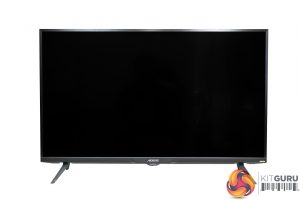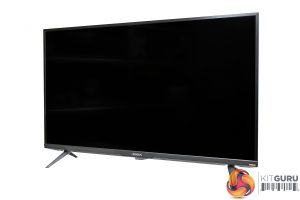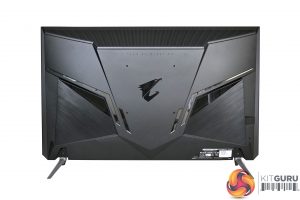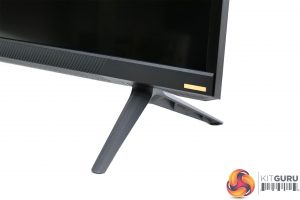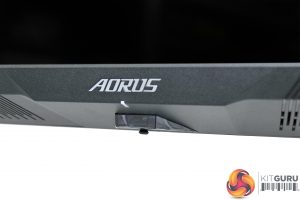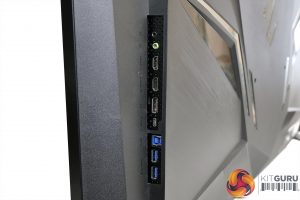Taking a look the design of the monitor, aside from the fact that this is a 43in display so it is obviously huge, I’d say Aorus has done well to keep the FV43U looking fairly understated. It has relatively thin bezels, and although it is not a bezel-less design, they are certainly not distracting. There's also no RGB lighting anywhere on the body, something which I’ve never really understood on a monitor.
The rear of the display is home to the Aorus logo and some brushed effect pieces, though the construction is plastic here and not metal. The FV43U also uses two TV-style feet which attach to the bottom corners of the display, and naturally this means there’s no ergonomic adjustments available – such as tilt or height adjust – but I’m not sure you’d really need such functionality for a screen this big. You can attach a third-party VESA 200 wall mount or stand if you want to though, so that option is there.
We can also note a small joystick positioned on the bottom edge of the display, used for navigating the OSD.
One of my annoyances with the design though, is the placement of the power input and connectivity ports on either side of the screen. If you’re looking at the front of the display, the I/O ports are on the right-hand side and the power input is on the left. This caused me a problem with cable routing, as putting the FV43U on my desk, it was very tight to get the cables to reach my PC, so I definitely would’ve preferred these to be mounted in a central location. This may not affect you at all but it is worth noting.
Speaking of the ports though, we get a healthy selection. There’s 2x HDMI 2.1, 1x DisplayPort 1.4, an audio jack, 1x USB-C, the USB upstream port, and then two USB Type-A downstream ports.
We do need to discuss the HDMI 2.1 ports however. While there are two of them, these are limited to just 24Gbps bandwidth, which is exactly half of the total bandwidth that HDMI 2.1 can offer. This is what we were told by Gigabyte, though when I reached out a second time to double-check the bandwidth limitations, I didn’t hear back from them before publishing this review. Rtings.com also tested the Aorus FI32U and they found the HDMI ports on that display were also limited to 24Gbps, so we can safely assume that is what is going on here.
Though that limitation is certainly not ideal, the good news is anyone with a HDMI 2.1 capable GPU – meaning Nvidia RTX 30 series or AMD RX 6000 series – can use Display Stream Compression (DSC) over HDMI 2.1 and still get a 4K/144Hz, 10-bit image without any chroma subsampling. The latest Xbox consoles can also use DSC, but if you’ve got a PS5, unfortunately you’ll be limited to 4:2:0 subsampling at 4K/120Hz. The PS5’s HDMI 2.1 ports are already limited to 4:2:2 subsampling as a result of their 32Gbps bandwidth ports, but the even more limited ports on the FV43U means 4:2:2 subsampling is a step too far.
Unfortunately, I don’t have a PS5 myself to test this in practice, but I did try comparing 4:4:4 and 4:2:0 subsampling on my PC. As shown in the video on the first page, there was a noticeable different in terms of text and colour representations in Windows, but the difference when gaming was far less noticeable to me when standing a couple of feet from the screen.
Still, this is definitely something to be aware of, especially if you were planning on using this monitor with a PS5. Many people will be considering this screen or something like the LG CX, too, with the CX offering 40Gbps bandwidth with its HDMI 2.1 ports, completely negating the issue.
Be sure to check out our sponsors store EKWB here
 KitGuru KitGuru.net – Tech News | Hardware News | Hardware Reviews | IOS | Mobile | Gaming | Graphics Cards
KitGuru KitGuru.net – Tech News | Hardware News | Hardware Reviews | IOS | Mobile | Gaming | Graphics Cards


